| Gravensteen | |
|---|---|
| Ghent, East Flanders | |
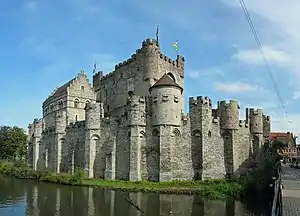 The Gravensteen, seen from the south-east | |
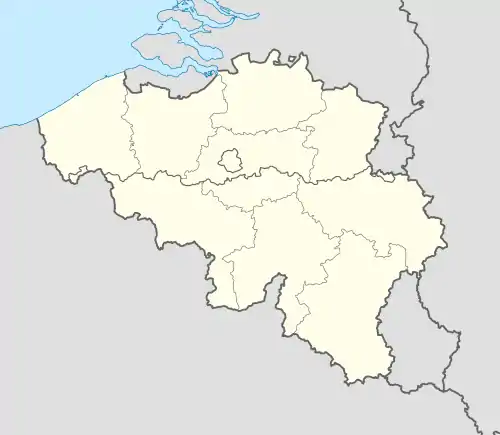 Gravensteen | |
| Coordinates | 51°03′26″N 3°43′14″E / 51.057222°N 3.720556°E |
| Type | Castle |
| Site information | |
| Owner | City of Ghent |
| Open to the public | Yes |
| Condition | Restored |
| Site history | |
| Built | 1180 |
| Materials | Sandstone, Tournai limestone |
| Garrison information | |
| Occupants | Counts of Flanders (1180–1353) |
The Gravensteen (Dutch; lit. 'the Counts' rock') is a medieval castle in the city of Ghent, East Flanders in Belgium. The current castle dates from 1180 and was the residence of the Counts of Flanders until 1353. It was subsequently re-purposed as a court, prison, mint, and even as a cotton factory. It was restored over 1893–1903 and is now a museum and a major landmark in the city.
Origins
The origins of the Gravensteen date to the reign of Arnulf I (890–965).[1] The site, which sat between two branches of the river Lys, was first fortified around 1000, initially in wood and later in stone. This was soon transformed into a motte-and-bailey castle which burnt down in around 1176.[1]
The current castle dates to 1180 and was built by Philip of Alsace (1143–1191) on the site of the older fortification.[1] It may have been inspired by crusader castles witnessed by Philip during the Second Crusade. As well a protective citadel, the Gravensteen was intended to intimidate the burghers of Ghent who often challenged the counts' authority. It incorporates a large central donjon, a residence and various smaller buildings. These are surrounded by a fortified, oval-shaped enceinte lined with 24 small échauguettes. It also has a sizeable moat, fed with water from the Lys.
From 1180 until 1353, the Gravensteen was the residence of the Counts of Flanders. The decision to leave was taken by Louis of Male (1330–1384) who transferred the court to the nearby Hof ten Walle.[1]
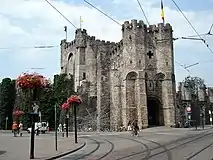 External view of the gatehouse
External view of the gatehouse The dedication stone, dating to 1180
The dedication stone, dating to 1180 View of the south side of the donjon
View of the south side of the donjon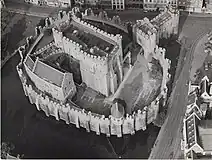 Aerial view of the castle, c.1970
Aerial view of the castle, c.1970
Subsequent history
After ceasing to be the residence of the counts of Flanders, the castle entered a decline. It was used as a court and prison until the 18th century. From 1353 to 1491, it was the site of Ghent's mint and private buildings were later constructed on or around the Medieval remains. During the Industrial Revolution, the Gravensteen was converted into a cotton mill by an industrialist who purchased the site. It was even scheduled for demolition.
Parts of the castle were bought up gradually by the City of Ghent which began a major restoration in a romanticising Gothic style between 1893 and 1907 under the architect Joseph de Waele.[1] De Waele was inspired the approach of the French architect Eugène Viollet-le-Duc and attempted to restore the castle to its imagined appearance in the 12th century. Many details added during this period, such as the flat roofs and the windows of the eastern outbuilding, are not thought to be historically accurate.
The Gravensteen was the centrepiece of the Ghent World Fair of 1913 during which the city centre was significantly reshaped. It remains open to the public.
"The Battle of Gravensteen Castle" took place in 1949 when 138 students from the University of Ghent occupied the castle over a new tax on beer. In addition to barricading the castle gates and lowering the portcullis, they captured the only guard on duty and locked him in a closet. After raising banners along the castle walls and pelting passing police officers with rotten fruit, they were eventually detained and removed from the castle, though a public outcry of support led to none of the students being prosecuted for their actions. Their campaign against the beer tax was unsuccessful.[2][3]
 Saint Catharine seated in the castle. Illumination by Simon Bening from the manuscript Hortulus Animae (1510)
Saint Catharine seated in the castle. Illumination by Simon Bening from the manuscript Hortulus Animae (1510)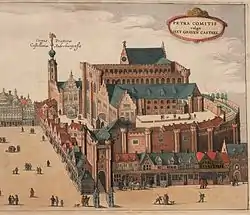 The Gravensteen, depicted in Flandria Illustrata (1641)
The Gravensteen, depicted in Flandria Illustrata (1641).PNG.webp) View of the Gravensteen's gatehouse in 1823, prior to the restoration
View of the Gravensteen's gatehouse in 1823, prior to the restoration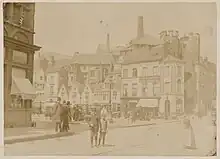 Photo of the castle before the restoration, c.1880. The factory buildings are still visible.
Photo of the castle before the restoration, c.1880. The factory buildings are still visible..jpg.webp) The castle, pictured in 1893 during the restoration work. The buildings around the castle have been demolished.
The castle, pictured in 1893 during the restoration work. The buildings around the castle have been demolished.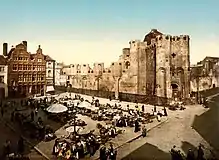 Photochrom picture of the castle in the later stages of the restoration, c.1900
Photochrom picture of the castle in the later stages of the restoration, c.1900
See also
References
- 1 2 3 4 5 "History". Gravensteen. Historische Huizen Gent. Retrieved 6 September 2018.
- ↑ White, Olivia (2023-06-20). "The Beer-Fueled Student Prank That Went Down in Belgian History". VinePair. Retrieved 2023-09-13.
- ↑ Brooks, Jay (2020-11-17). "The Battle of Gravensteen Castle". Brookston Beer Bulletin. Retrieved 2023-09-13.



.jpg.webp)